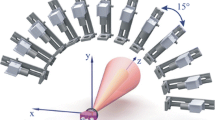Abstract
Thermal spray and other high-temperature industrial processes are quite difficult to monitor with the human eye, because the luminous volume of the plasma or flame obscures the behavior of the solid or molten material in the heat-affected area. When a photographic or video camera is used, viewing is further degraded by the extreme contrast variation across the image area, making it impossible to achieve proper exposure throughout the image—except possibly for small areas of comparable brightness. Optical filtering with neutral density filters, such as those used in a welder’s helmet, are of no practical benefit. With thermal spray processes, the injection and flow of particles within the plasma flame is almost totally concealed by the extreme brightness of the plasma, flame, or arc. In addition, the particles quickly accelerate to very high speeds, making their detection even more difficult. This article discusses the development of integrated thermal spray process monitoring and analysis techniques based on two principles. The first is a unique vision sensing system that suppresses the flame, plasma, arc, or other high-luminosity phenomena in the video image. A further improvement is the use of dedicated image and analysis processing to enhance the sensor images and extract features of interest or dimensional measurements. These experimental techniques can be used as feedback for automated process monitoring and control.
Similar content being viewed by others
References
E. Pfender, Fundamental Studies Associated with the Plasma Spray Process,Proc. Thermal Spray—Advances in Coatings Technology Conf., (1988) 1-10.
S.G. Lee and S. Safai, Automation of the Thermal Spray Process,Advances in Thermal Spraying, Proc. 1 lth Int. Thermal Spraying Conf., vol 11, (1986) 197–207.
F.J. Hermanek, “Manufacturing Technology for Thermal Spray Processes,” AFWAL-TR-79-4186 (1979).
K.D. Borbeck, Robotics & Manipulators for Automated Plasma Spraying & Vacuum Plasma Spraying,Proc. 10th Int. Thermal Spraying Conf., vol 10, (1983) 99–104.
P.C. Wolf, New Trends in the Automation of Thermal Spray Sys- tems,Proc. 10th Int. Thermal Spraying Conf., vol 10, (1983) 95–99.
W.R. Butts and R.K. Betts, Improved Thermal Spray Process Con- trol Concept By Use of Linear Gas Mass Flow Controllers & Constraints Over Primary Variables,Proc. 2nd Nat. Conf. Thermal Spray, (1985) 45-50.
M.L. Thorpe, Recent Advances in Arc Coating Technology,Thermal Spray Coatings—New Materials, Processes & Applications, Proc. 2nd Nat. Conf. Thermal Spray, (1985) 91-100.
A.R. Nicoll and H. Eschnauer, Quality Assurance of Plasma-Spray Powders,Advances in Thermal Spraying, Proc. 11th Int. Thermal Spraying Conf., vol 11, (1986) 289–298.
H.-M. Hohle, Application of Computer-Controlled Spray Systems to Increase Quality of LPP Sprayed Coatings,Proc. 11th Int. Thermal Spraying Conf, vol 11, (1986) 209–219.
W. Ostergaard, Volumetric Feedback Powder Feed Controller,Thermal Spray Coatings—New Materials, Processes & Applications, Proc. 2nd Nat. Conf. Thermal Spray, (1988) 39-44.
J.A. Saenz, Automated Powder Mass Flow Monitoring & Control,Proc. Thermal Spray—Advances in Coatings Technology Conf., (1988)215-221.
G. Irons, The HAWCS II System for Robotic Plasma Spraying,Int. Thermal Spray Conf., Pittsburgh (1991).
J.E. Agapakis and G. Irons, Advances in Robotic Plasma Spraying, accepted for presentation at the Int. Thermal Spray Conf., Orlando, l-5Junl992.
J.E. Agapakis, J.M. Katz, and D.L. Pieper, Programming & Control of Multiple Robotic Devices in Coordinated Motion,Proc. 1990 lEEE Int. Conf. Robotics and Automation, (1990) 362-367.
J.E.Agapakis, J.M.Katz, and M.R.Wall, A Multi-Robot Coordinated Motion Programming & Control System,Proc. 1990 Int. Robots & Vision Automation, Detroit,13-1 to 13-14, Jun(1990).
W. Mayr, Rapid Optimization of Spraying Parameters by Means of an Automatic Laser Doppler Measuring Equipment,Proc. 11th Int. Thermal Spraying Conf, vol 11, (1986) 221–230.
H.D. Steffenset al., Spray Particle Behavior in a Low Pressure Plasma Jet,Advances in Thermal Spraying, Proc. 11th Thermal Spray Conf., vol 11,(1986) 49–59.
M. Smith and R.C. Dykhuizen, The Effect of Chamber Pressure on Particle Velocities in Low-Pressure Plasma Spray Deposition,Proc. Advanced in Coatings Technology Conf., (1985) 91-100.
D. Marr,Vision: A Computational Investigation of the Human Representation & Processing of Visual Information, W.H. Freeman, San Francisco (1982).
R.C. Gonzalez and P. Wintz,Digital Image Processing, Addison Wesley, Reading (1987).
S. Karandanis, Imaging Lands on VME,OEM Integrator, 1(3), (1990)50–57.
Author information
Authors and Affiliations
Rights and permissions
About this article
Cite this article
Agapakis, J., Hoffman, T. Real-time imaging for thermal spray process development and control. JTST 1, 19–25 (1992). https://doi.org/10.1007/BF02657013
Issue Date:
DOI: https://doi.org/10.1007/BF02657013




